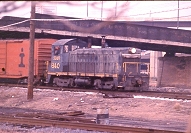 |
Camden Yard in the 1970s and 1980s - before Oriole Park and a statement by some pinhead judge that "when people hear 'Camden Yards' they think of baseball..." |
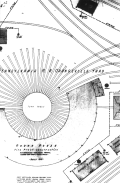 |
Orangeville (near Highlandtown in East Baltimore), the Pennsylvania Railroad's locomotive facility |
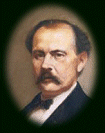 |
Odenton, Maryland - a town built around the Baltimore & Potomac Railroad in the 1800s, served by the Pennsylvania until the 1960s and still served by MARC
(the Maryland commuter rail system) today |

|
US&S Bulletin No. 61, covering Automatic Block Signaling installed on the Washington, Baltimore and Annapolis Electric Railroad in 1912.
|

|
WB&A tracks in Annapolis, uncovered during street repaving in 2000
|
Mechanical interlocking fascinates many railfans today - both modelers and non-modelers.
I can't speak for others, but for me it's a reminder of the Golden Age of railroading
when steam ruled the rails and America had more rail lines than highways. Every time I
happen to come across a relic of this practice my mind instantly goes back to the "war years"; I hear Glenn
Miller and Count Basie playing the top hits of the day, and I feel the ground shake
as a train loaded with war materials and pulled by a double-header of K-4s thunders by,
by. belching smoke and cinders into the sky and leaving behind the wonderfully pungent odor
of coal burining.
I have always wanted to get my hands on the manuals and guides
related to this aspect of railroading - and I have finally achieved a major milestone in my
quest: I got a copy of the American Railway Association, signal Section Signalling Principles
and Practices, volume 17, from 1933. Even more surprising to me than the fact that I won
it on eBay to begin with is the fact that I didn't have to pay a hundred dollars or more
for it.
Well, that's enough of my babbling; here, for your reading pleasure, is the American Railway Association
Signalling Principles and Practices, Chapter XVII, Mechanical and Electro-Mechanical
Interlocking. I hope you enjoy reading this book as much I have enjoyed preparing it
for the web so that more people might appreciate the wealth of information it
contains. Happy reading!
|
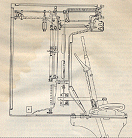 |
Part 1 of Chapter 17 of the ARA 1933 manual of signalling practice. Covers several examples of mechanical
and electromechanical interlocking machines. |
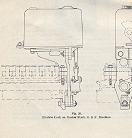 |
Part 2 of Chapter 17 of the ARA 1933 manual of signalling practice. Covers the first part of manual concerning electric locks. |
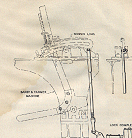 |
Part 3 of Chapter 17 of the ARA 1933 manual of signalling practice. Covers the second part of manual concerning electric locks. |
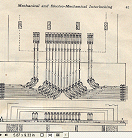 |
Part 4 of Chapter 17 of the ARA 1933 manual of signalling practice. Covers different types of leadout arrangements. |
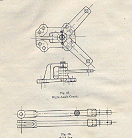 |
Part 5 of Chapter 17 of the ARA 1933 manual of signalling practice. Covers pipe and pipe carriers. |
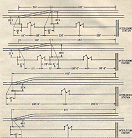 |
Part 6 of Chapter 17 of the ARA 1933 manual of signalling practice. Covers compensation and compensators in pipe lines. |
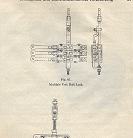 |
Part 7 of Chapter 17 of the ARA 1933 manual of signalling practice. Covers switches and signals |
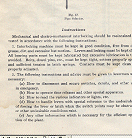 |
Part 8 of Chapter 17 of the ARA 1933 manual of signalling practice. Don't know how to maintain that old armstrong
machine your grandfather left you? This will tell you all you need to know.. |
Of course there are other beloved remnants of the Golden Age.
One of my personal favorites - other than mechanical interlocking - is the Baltimore
and Ohio's Color-Position Light (CPL) signals.
|
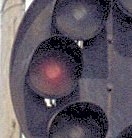 |
Graphic depictions of the B&O signal indications from 1941. |
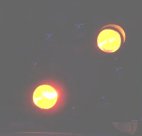 |
My trials and tribulations restoring
a four-indication B&O CPL from Halethorpe, Maryland |
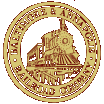 |
A breif history of railroads in Annapolis, Maryland |
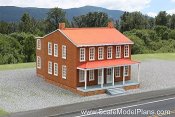 |
A beginner's tutorial on scratch-building |
| Since there has been such overwhelming indifference to my tale of how I got started watching trains, I'm leaving it here for the world to see (sorry, world!):
WHEN I WAS but a wee lad of 11 years I spent many a summer's day at my Aunt Estelle's house at 13 Hill Street in Annapolis. Near the back of Aunt Estelle's house was a small, somewhat steep hill, and
along the bottom of that hill ran the tracks of the Baltimore and Annapolis Railroad. Since the railroad was waning due to heavy competition from trucking the B&A ran only two or three trains a week into
town - a special train of coal cars for the U. S. Naval Academy's steam plant at the corner of King George Street and MD route 450, or a mixed jumble of coal for the Henry B. Meyers
(who had a coal trestle behind the bus station and Rescue Hose fire station on West Street), plus giant rolls of newsprint for the Evening Capital, lumber for Meredith Roane lumber on "outer" West Street and a LCL boxcar of other
varied and sundry freight for the warehouse that was also behind the bus station.
After an incident involving a lump of coal and a related "vision", being an inquisitive child I began to ask questions of my mother and my aunts and uncles who had grown up in that very neighborhood; they related grand tales of shiny metal interurban cars that rumbled down
the rails at what seemd like high speeds at that time (the 1930s and 1940s) and of old rickety wooden cars with windows that wouldn't open in the middle of August - or close in the throes of a January blizzard. I was fascinated, and an amateur railroad historian was born.
As the years went on I discovered the Maryland State Archives in a small brick building on the grounds of St. John's College in Annapolis. I learned, through files held there, that the trains I watched as a child
ran on tracks that were on the very same roadbed as had been originally surveyed and built for the Annapolis and Elk Ridge Rail Road in 1831. Though I hadn't known it when I was but a wee lad of 11, I
was watching the final act of a play that had been running on the same stage for over 130 years.
How can I not be interested in railroad history after that!
|
|
 Safety First
Safety First

|
In 2020...
1,889 vehicles raced trains to grade crossings - and tied;
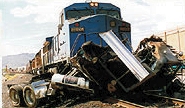
202 people in those vehicles died
Don't become a statistic - look, listen and live!
|


